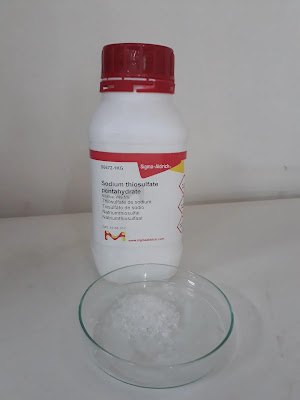Contents
hide
CHEMICAL PRODUCT IDENTIFICATION
- Product Name: Sodium Thiosulfate Pentahydrate.
- Signal Word: N/A.
- Read – Sodium Thiosulfate Pentahydrate SDS!
HAZARDS IDENTIFICATION
- According to GHS classifications for the Hazard Communication Standard, this chemical is not deemed dangerous.
- All laboratory substances should be handled with care.
- Although this substance is thought to be nonhazardous, unanticipated chemical reactions are always a possibility.
- Laboratory procedures should be followed carefully.
COMPOSITION, INFORMATION ON INGREDIENTS
- Name of Component: Sodium Thiosulfate Pentahydrate.
- CAS Number: 10102-17-7.
- Molecular Formula: Na2S2O3.5H2O.
- Synonyms: Sodium Hyposulfite, Disodium thiosulfate pentahydrate, Sodium Thiosulfate Pentahydrate.
- Molecular/Formula Weight: 248.18.
FIRST-AID MEASURES
- If you feel unwell, contact a doctor.
- If inhaled: Remove the victim to fresh air & keep them at rest in a breathing-friendly position.
- If in the eyes: Carefully rinse for a few minutes with water. If contact lenses are present & simply possible to remove, do so. Rinsing continues.
- If on the Skin: Use lots of water for washing.
- If Swallowed: Rinse your mouth. If you feel sick, make a doctor’s appointment.
FIRE-FIGHTING MEASURES
- It appears as solid that doesn’t catch fire.
- Produces dangerous gases when heated.
- Use a tri-class dry chemical fire extinguisher in the event of a fire (Use carbon dioxide, foam, dry chemical, or water spray).
ACCIDENTAL RELEASE MEASURES
- Clean up, put in a sealed bag or container, & throw away (Dispose of).
- After the debris has been collected, ventilate the area & clean the spill site.
HANDLING & STORAGE
- Store alongside phosphates, sulfates, sulfites, acetates, & halides.
- A little bit liquescent (smooth) in the humid air.
- Warm, dry air is efflorescent for it.
- Maintain the container in a dry, well-ventilated area with the lid well shut.
- It is suggested to keep it in a Chemical safety bag.
EXPOSURE CONTROLS, PERSONAL PROTECTION
- Wear safety gear, including gloves, clothes, & eye protection.
- After handling, carefully wash your hands.
PHYSICAL & CHEMICAL PROPERTIES
- Physical State: Solid.
- Appearance: crystals or powder that is white & translucent.
- Odor: It is odorless.
- Melting Point: 48°C, melting point (decomposes).
- Boiling Point: 100°C.
- Solubility: It is soluble in water & insoluble in alcohol.
- Density(Specific-Gravity): 1.69 g/cm3.
STABILITY & REACTIVITY
- Prevent coming into contact with lead, silver(salts), mercury salts, iodine, acids, & strong oxidizers.
- It has a poor shelf life.
TOXICOLOGICAL INFORMATION
- Acute Effects: May be Irritant.
- Chronic Effects: N/A.
- Target Organs: N/A.
- LD50 for ORL-HUM: N/A.
- LC50 for IHL-RAT: N/A.
- LD50 for SKN-RBT: N/A.
ECOLOGICAL INFORMATION
- No ingredients that are persistent, bioaccumulative, & toxic (PBT) or very persistent & very bioaccumulative (vPvB) at levels of 0.1% or more are present in this item or mixture.
DISPOSAL CONSIDERATIONS
- Dispose of in accordance with local, state, & federal rules or laws.
TRANSPORT INFORMATION
- Name of shipment: Unrestricted. Risk category: N/A. UN identifier: N/A.
- It is not considered dangerous goods.
REGULATORY INFORMATION
- EINECS-listed (231-867-5).
- Regulation (EC) No. 1907/2006 is complied with by this material safety data sheet.
- Assessment of Chemical Safety: A chemical safety assessment for this product wasn’t done.
OTHER INFORMATION
This Sodium Thiosulfate Pentahydrate SDS is intended as a piece of advice & is based on data & tests that are likely to be reliable. I don’t guarantee the data’s correctness or completeness & I’m not responsible for any resulting losses. The information is only being provided for your review, research, & verification. I DO NOT ASSUME RESPONSIBILITY AND EXPRESSLY DISCLAIM LIABILITY FOR LOSS, DAMAGE, OR EXPENSE RESULTING FROM OR IN ANY WAY CONNECTED WITH THE HANDLING, STORAGE, USE, OR DISPOSAL OF THIS PRODUCT FOR THE FOREGOING AND OTHER REASONS.
Click to read: Sigma Aldrich SDS for Sodium Thiosulfate Pentahydrate SDS

CONCLUSION
Chemical substances like sodium thiosulfate pentahydrate should be handled carefully to reduce any risks to human health & the environment. The Globally Harmonized System of Classification & Labeling of Chemicals (GHS) does not classify it as a hazardous material, but it can still be harmful if consumed, breathed, or in contact with the skin & eyes. To avoid unintentional exposure, it is advised to use the proper protective equipment & adhere to excellent industrial hygiene procedures when handling sodium thiosulfate pentahydrate. To lessen the influence on the environment, proper waste disposal should also be taken into account. One must always follow Sodium Thiosulfate Pentahydrate SDS.
